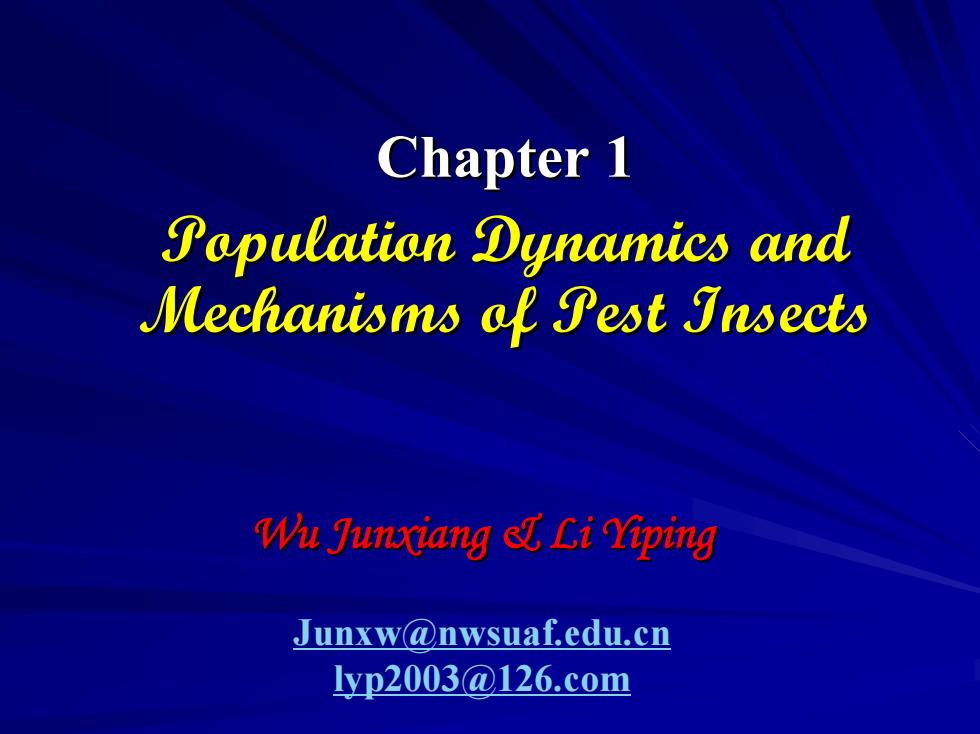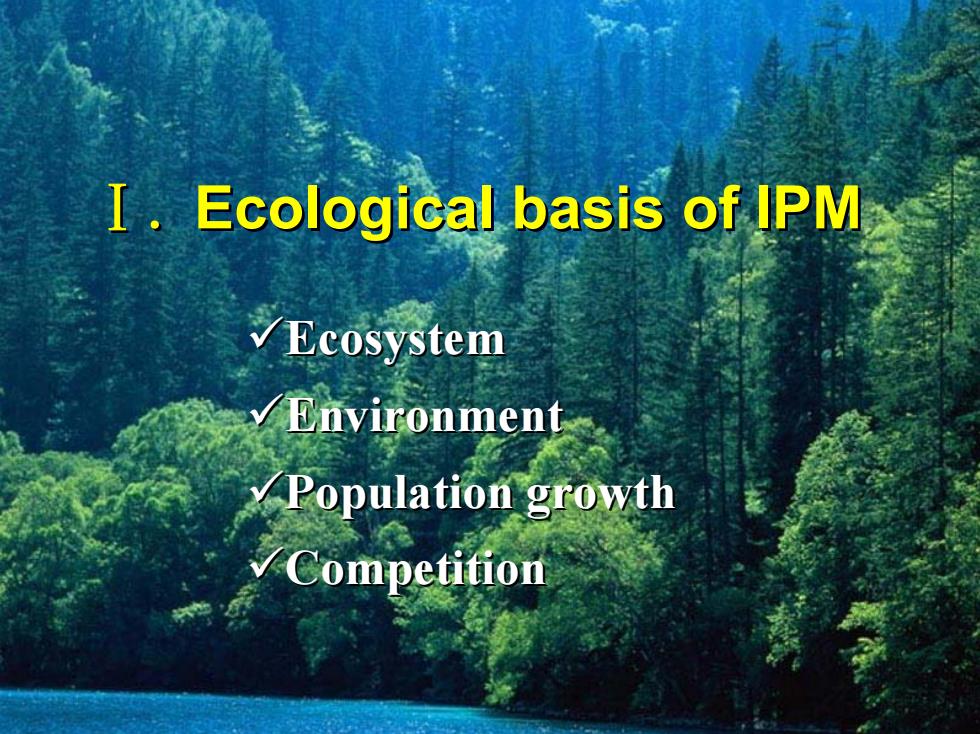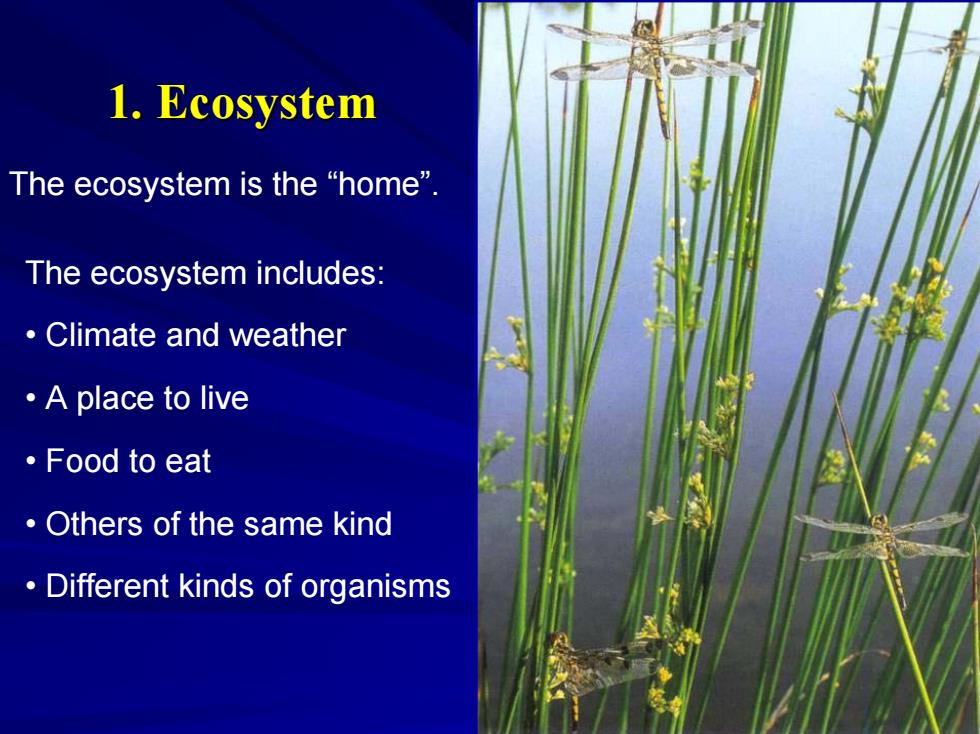
Chapter 1 Population Dynamics and Mechanisms of Pest Insects Wu Junxiang Li Yiping Junxw@nwsuaf.edu.cn yp2003@126.com
Chapter 1 Chapter 1 Population Dynamics and Population Dynamics and Mechanisms of Pest Insects Mechanisms of Pest Insects Wu Junxiang Junxiang & Li Yiping Junxw@nwsuaf.edu.cn lyp2003@126.com

Lecture outline: Ecological basis of IPM Economic principles of IPM Categories of pest insects and conditions causing disaster >Survey on and sampling of pest insects Forecast of pest insects
Lecture outline: Lecture outline: ¾ Ecological basis of IPM Ecological basis of IPM ¾ Economic principles of IPM Economic principles of IPM ¾ Categories of pest insects and Categories of pest insects and conditions causing disaster conditions causing disaster ¾ Survey on and sampling of pest Survey on and sampling of pest insects insects ¾ Forecast of pest insects Forecast of pest insects

I.Ecological basis of IPM Ecosystem Environment Population growth Competifion
Ⅰ. Ecological basis of IPM Ecological basis of IPM 9Ecosystem Ecosystem 9Environment Environment 9Population growth Population growth 9Competition Competition

Ecology (lit.)study of the abode or home Community-level The economy of nature (energy flow)and the interaction among environmental factors that may affect this flow. Community Population-level The distribution and abundance of organisms as affected by their environment. Population Individual-level The effect of the environment on survival and reproduction. Individual
Ecology = (lit.) study of the abode or home Community-level = The economy of nature (energy flow) and the interaction among environmental factors that may affect this flow. Population-level = The distribution and abundance of organisms as affected by their environment. Individual-level = The effect of the environment on survival and reproduction

1.Ecosystem The ecosystem is the "home". The ecosystem includes: ·Climate and weather ·A place to live ·Food to eat Others of the same kind Different kinds of organisms
The ecosystem is the “home”. The ecosystem includes: • Climate and weather • A place to live • Food to eat • Others of the same kind • Different kinds of organisms 1. Ecosystem 1. Ecosystem

1.Ecosystem Insects are affected by the: abiotic (physical) condition of the environment,and by CADDIS-FLY LARVAE biotic interactions (interactions with other living things). MOSE LA BLACXFLY LARVA How do we measure MAYFLY NYMPHS these effects? FILAMENTOUS ALGAE DET南TUS
Insects are affected by the: abiotic (physical) condition of the environment, and by biotic interactions (interactions with other living things). How do we measure these effects? 1. Ecosystem

2.Environment 1)Niche A species'place in the environment is its niche the set of environmental conditions under which individuals can exploit resources effectively enough to reproduce
1) Niche A species’ place in the environment is its niche = the set of environmental conditions under which individuals can exploit resources effectively enough to reproduce. 2. Environment 2. Environment

2.Environment 2 E The niche is where they E live and what they do their role "You call this a niche?
The niche is where they live and what they do - their role 2. Environment 2. Environment

2.Environment 2)Microhabitat Insects really live in a small world!! They live in a microhabitat that may be different from the surrounding environment.Surfaces (i.e.,leaves,soil) affect temperature and moisture in the boundary layer layer of fluid (air or water)next to a surface.Insects are often small enough to live in a boundary layer
2) Microhabitat Insects really live in a small world!! They live in a microhabitat that may be different from the surrounding environment. Surfaces (i.e., leaves, soil) affect temperature and moisture in the boundary layer = layer of fluid (air or water) next to a surface. Insects are often small enough to live in a boundary layer. 2. Environment 2. Environment

2.Environment Microhabitat Insects also live in microhabitats that are protected from outside conditions: Inside plants -stem borers,leaf miners,gall makers ·In soil-grubs,ants In water-dragonfly nymphs, mosquito larvae,caddisflies In association with animals (under fur,in burrows,etc.)-lice,fleas In hives or nests bees,termites
• Inside plants - stem borers, leaf miners, gall makers • In soil - grubs, ants • In water - dragonfly nymphs, mosquito larvae, caddisflies • In association with animals (under fur, in burrows, etc.) - lice, fleas • In hives or nests - bees, termites 2. Environment - Microhabitat Insects also live in microhabitats that are protected from outside conditions: